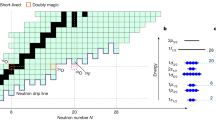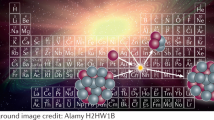Abstract
EARLY experimental observations on the range of fission fragments in air1 suggested that the kinetic energy of fragments of nearly equal mass formed in fission (that is, symmetrical fission) was less than that of fragments of different mass (that is, in unsymmetrical fission), and very recent measurements2 have clearly confirmed this, and shown that the deficiency amounts to about 30 MeV. (32,210 micro-mass units, µM.U.). The conservation of energy in fission may be expressed by an equation of the form:  where AZM's are the masses of the fissioning nucleus and of the fragments, 1 and 2, of mass number A and charge Z, and E12 is the energy released expressed in mass units. This last appears as the kinetic energy of the fragments together with the neutrons and γ-rays emitted in fission. It has been shown3 that the neutrons and γ-rays associated with symmetrical fission are not markedly greater in energy than those associated with unsymmetrical fission, and it appears that the deficiency in the kinetic energy in question must be associated with an excess in the masses of the unstable fragments. The masses of the unstable fragments formed initially in fission are not known, however, and attempts to predict them from present empirical mass formulæ have not shown the expected mass excess4.
where AZM's are the masses of the fissioning nucleus and of the fragments, 1 and 2, of mass number A and charge Z, and E12 is the energy released expressed in mass units. This last appears as the kinetic energy of the fragments together with the neutrons and γ-rays emitted in fission. It has been shown3 that the neutrons and γ-rays associated with symmetrical fission are not markedly greater in energy than those associated with unsymmetrical fission, and it appears that the deficiency in the kinetic energy in question must be associated with an excess in the masses of the unstable fragments. The masses of the unstable fragments formed initially in fission are not known, however, and attempts to predict them from present empirical mass formulæ have not shown the expected mass excess4.
This is a preview of subscription content, access via your institution
Access options
Subscribe to this journal
Receive 51 print issues and online access
$199.00 per year
only $3.90 per issue
Buy this article
- Purchase on Springer Link
- Instant access to full article PDF
Prices may be subject to local taxes which are calculated during checkout
Similar content being viewed by others
References
Katcoff, S., Miskel, J. A., and Stanley, C. W., Phys. Rev., 74, 631 (1948).
Gibson, W. M., Thomas, T. D., and Miller, G. L., Phys. Rev. Letters, 7, 65 (1961). Milton, J. C. D., and Fraser, J. S., Phys. Rev. Letters, 7, 67 (1961).
Stein, W. E., and Whetstone, jun., S. L., Phys. Rev., 110, 476 (1958). Fraser, J. S., and Milton, J. C. D., ibid., 93, 818 (1954). Milton, J. C. D., and Fraser, J. S., ibid., 111, 877 (1958).
Fong, P., Phys. Rev., 102, 434 (1956). Newton, T. D., Atomic Energy of Canada, Ltd., Report CRL-642-A (1956). Cameron, A. G. W., Second Geneva Conf. on Peaceful Uses of Atomic Energy, 15, 425 (1958).
Koenig, L. A., Mattauch, J. H. E., and Wapstra, A. H., 1960 Nuclear Data Tables, Part 2 (Nat. Acad. Sci., Washington, D.C.).
Glendenin, L. E., Coryell, C. D., and Edwards, R. R., N.N.E.S. The Fission Products Paper 52 (McGraw-Hill, 1951).
Author information
Authors and Affiliations
Rights and permissions
About this article
Cite this article
WALTON, G. The Balance of Energy in Nuclear Fission. Nature 192, 1062–1064 (1961). https://doi.org/10.1038/1921062a0
Issue Date:
DOI: https://doi.org/10.1038/1921062a0
Comments
By submitting a comment you agree to abide by our Terms and Community Guidelines. If you find something abusive or that does not comply with our terms or guidelines please flag it as inappropriate.



